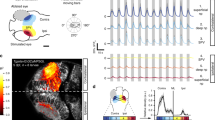Summary
-
1.
Recent experiments have shown that toads discriminate prey from enemy objects by using two “gestalt” information mechanisms: (i) The surface expansionin the direction of movement means prey; (ii) the expansionperpendicular to the direction of movement signifies enemy. Both parameters are encoded by particular neuronal “gestalt” filters: one of them (i) is located in the optic tectum (tectum-1-neurons) and the other (ii) in the thalamus/pretectal region.
-
2.
It was supposed that prey recognition is due to subtractive interactions between both tectum-1- and thalamus/pretectal-neurons: A second neuron in the optic tectum receives excitatory inputs from tectum-1-neurons and inhibitory ones from particular units of the thalamus/pretectal region.
-
3.
After elimination of the thalamus/pretectal region from the optic tectum by a careful knife cut (Fig. 2) the responses of tectum-1- and -2-neurons to visual stimulus objects, moved through their receptive fields, were “disinhibited” (compare Figs. 3Aa and b). It is remarkable that there was no effect on the size of the excitatory receptive fields. The field diameter of tectal neurons of this layer in normal and lesioned toads was about 27 °.
-
4.
The fact that after thalamus/pretectal lesions the tectum-1- as well as tectum-2-neurons show the same increase of response with increasing size of moving stimuli, indicates that the recently presented “neuronal interaction model” for the prey recognition system describes thebasic wiring.
-
5.
The present neuro-physiological findings (Fig. 3A2a and b) are in good accordance with corresponding effects on the prey-catching behavior (Fig. 3Ba and b): As a result of thalamus/pretectal lesions toads are not able to discriminate visual patterns in a behaviourally relevant manner. Their prey-catching behavior is “disinhibited”.
Zusammenfassung
-
1.
Frühere Experimente hatten gezeigt, daß Kröten für die Unterscheidung Beute/Feind hauptsä chlich zwei „Gestalf”-Informationen nutzen: (i) Die Flä chenausdehnung in der Bewegungsrichtung bedeutet generell Beute, (ii)Ausdehnung quer zur Bewegungsrichtung signalisiert dagegen Feind. Beide Parameter werden durch bestimmte „neuronale Filter” ausgewertet, von denen der eine (i) im Tectum opticum (Teetum-1-Neurone) und der andere (ii) in der Thalamus/Praetectum-Region lokalisiert ist.
Es wurde vermutet, daß das Beute-Erkennungssystem auf subtraktiver Interaktion zwischen den Tectum-1- und Thalamus/Praetectum-Neuronen beruht. Hierbei erhält ein weiteres Neuron im Tectum opticum (Tectum-2-Neuron) erregende Eingänge von Tectum-1- und hemmende von Thalamus/Praetectum-Neuronen.
-
2.
Nach Abtrennung der Thalamus/Praetectum-Region vom Tectum opticum mit Hilfe eines Messerschnitts war die Antwort der Tectum-1- und -2-Neurone auf bewegte visuelle Eeizmuster „enthemmt”. Die Größe ihrer exzitatorischen rezeptiven Felder von ca. 27 ° Durchmesser blieb hiervon jedoch unbeeinflußt.
-
3.
Die Tatsache, daß sowohl Tectum-2- als auch Tectum-1-Neurone nach Thalamus/Praetectum-Ausschaltung bei Vergrößerung der Reizfläche eines Musters etwa den gleichen Aktivierungsanstieg zeigten, weist darauf hin, daß das bisherige „Interaktionsmodell” für die Beute/Feind-Erkennung das neuronale Verschaltungs-prinzip wiedergibt.
-
4.
Die neurophysiologischen Befunde stehen prinzipiell in guter Übereinstimmung mit entsprechenden quantitativen Resultaten über das Beutefangverhalten: Nach Ausschaltung der Thalamus/Praetectum-Region vermag die Kröte visuelle Muster nicht mehr verhaltensrelevant zu unterscheiden.
Similar content being viewed by others
Literatur
Ewert, J. -P.: Der Einfluß von Zwischenhirndefekten auf die Visuomotorik im Beutefang- und Fluchtverhalten der Erdkröte (Bufo bufo L.). Z. vergl. Physiol.61, 41–70 (1968)
Ewert, J. -P.: Neural mechanisms of prey-catching and aviodance behavior in the toad (Bufo bufo L.). Brain Behav. Evol.3, 36–57 (1970)
Ewert, J. -P.: Lokalisation und Identifikation im visuellen System der Wirbeltiere. Portschr. Zool.21, 307–333 (1973)
Ewert, J. -P.: The neural basis of visually guided behavior. Sci. Amer.230, 34–42 (1974)
Ewert, J. -P., Borchers, H. -W.: Reaktionscharakteristik von Neuronen aus dem Tectum opticum und Subtectum der ErdkröteBufo bufo (L.). Z. vergl. Physiol.71, 165–189 (1971)
Ewert, J.-P., Hock, F.-J., Wietersheim, A. v.: Thalamus, Praetectum, Tectum: Retinale Topographie und physiologische Interaktionen bei der KröteBufo bufo (L.). J. comp. Physiol. (im Druck) (1974)
Ewert, J. -P., Seelen, W. v.: Neurobiologie und Systemtheorie eines visuellen Muster-Erkennungsmechanismus bei Kröten. Kybernetik14, 167–183 (1974)
Ewert, J. -P., Wietersheim, A. v.: Musterauswertung durch Tectum- und Thalamus/Praetectum-Neurone im visuellen System der KröteBufo bufo (L.). J. comp. Physiol.92, 131–148 1974
Ingle, D.: Disinhibition of tectal neurons by pretectal lesions in the frog. Science180, 422–424 (1973)
Lettvin, J. Y., Maturana, H. R., Pitts, W. H., McCulloch, W. S.: Two remarks on the visual system of the frog. In: Sensory communication, W. A. Rosenblith, ed., pp. 757–776. Cambridge, Mass.: MIT Press 1961
Michael, Oh. R.: Integration of retinal and cortical information in the superior colliculus of the ground squirrel. Brain Behav. Evol.3, 205–209 (1970)
Wickelgren, B. G., Sterling, P.: Influence of visual cortex on receptive fields in the superior colliculus of cats. J. Neurophysiol.32, 16–23 (1969)
Author information
Authors and Affiliations
Additional information
Mit Unterstützung der Deutschen Forschungsgemeinschaft, Ew 7/6 und Forsch.-Gr. Az.: 741,29.
Rights and permissions
About this article
Cite this article
Ewert, J.P., von Wietersheim, A. Einfluß von Thalamus/Praetectum-Defekten auf die Antwort von Tectum-Neuronen gegenüber bewegten visuellen Mustern bei der KröteBufo bufo (L.). J. Comp. Physiol. 92, 149–160 (1974). https://doi.org/10.1007/BF00694503
Received:
Issue Date:
DOI: https://doi.org/10.1007/BF00694503




